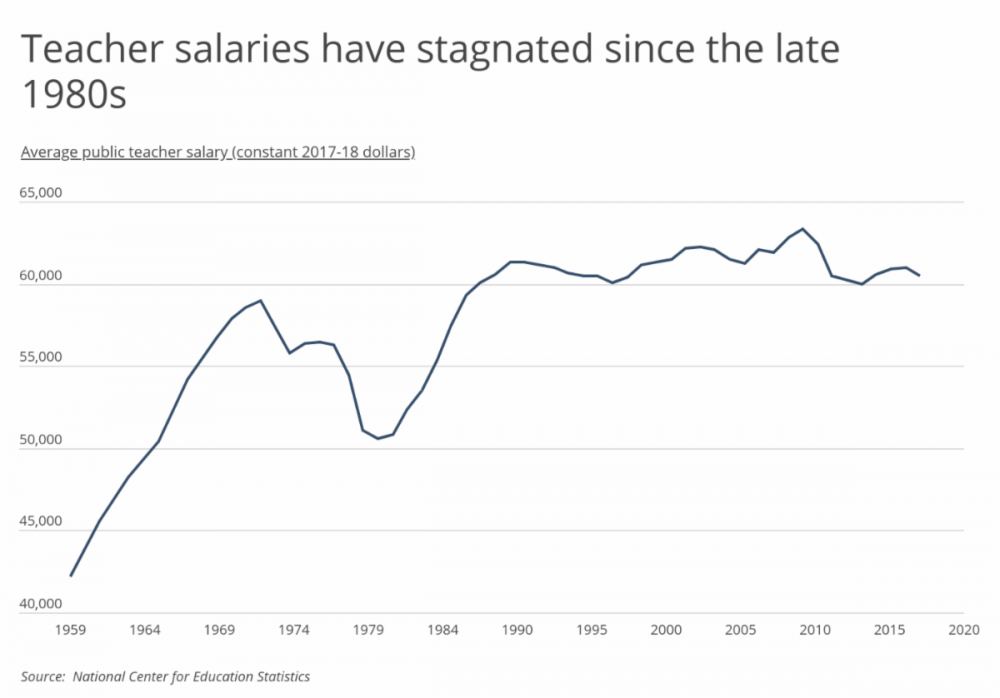With fall nearly here, schools across the country are solidifying their reopening plans amidst the pandemic. Teachers are becoming the new frontline workers, and with the virus resurging in many communities, a majority of teachers are worried about exposure to COVID-19 while on the job. Nationally, data from the Bureau of Labor Statistics shows that median annual earnings for teachers is just over $59,000, while according to data from the Census Bureau, median earnings for full-time bachelor’s degree holders is $70,000. Teacher pay is lagging behind many other professions, and now teachers face new risks due to the COVID-19 pandemic.
The number of teacher strikes has increased in recent years, with teachers fighting for better pay, benefits, and working conditions. According to data from the BLS, among the 425,500 workers involved in major work stoppages in 2019, over half were in the educational services industry. In real terms, teacher pay has changed little in the last 30 years. In 1988, the average public teacher’s salary was $60,529 in constant 2017-2018 dollars, slightly higher than what teachers make today.
Teacher salaries have not only stagnated, but teachers also earn considerably less than other workers with comparable levels of education. At just under $60,000, median teacher pay falls in between the median pay for associate’s degree holders and bachelor’s degree holders, despite a majority of teachers holding a post-baccalaureate degree. Nationally, teachers earn 15.7 percent less than all full-time workers with a bachelor’s degree or higher.
Teacher pay varies significantly by location, with teachers in some cities and states earning far more or less on average than others. At the state level, Arizona and Oklahoma have the largest teacher pay gaps in the country, with teachers earning 33.5 and 29.1 percent less than all full-time bachelor’s degree holders, respectively. At the other end of the spectrum, teachers in Rhode Island and New York tend to earn more than all full-time college-educated workers. In these states, median teacher pay is about 6 percent higher than that for all full-time bachelor’s degree holders.
To find the states with the largest teacher pay gap, researchers at Smartest Dollar, a review website for insurance and financial services, analyzed the latest data from the U.S. Census Bureau, the Bureau of Labor Statistics, and the Bureau of Economic Analysis. The researchers ranked states according to the pay gap between teachers and full-time workers with bachelor’s degrees. Researchers also calculated median annual earnings for teachers, median annual earnings for all full-time bachelor’s degree holders, and cost of living for each state.
The analysis found that in Tennessee, median annual earnings for teachers is 13.2% less than that of all full-time workers with bachelor's degrees. Here is a summary of the data for Tennessee:
- Teacher pay gap: -13.2%
- Median annual earnings for teachers: $51,237
- Median annual earnings for all full-time bachelor’s degree holders: $59,000
- Cost of Living: 10.1% below average
For reference, here are the statistics for the entire United States:
- Teacher pay gap: -15.7%
- Median annual earnings for teachers: $59,019
- Median annual earnings for all full-time bachelor’s degree holders: $70,000
- Cost of Living: N/A
For more information, a detailed methodology, and complete results, you can find the original report on Smartest Dollar’s website: https://smartestdollar.com/





